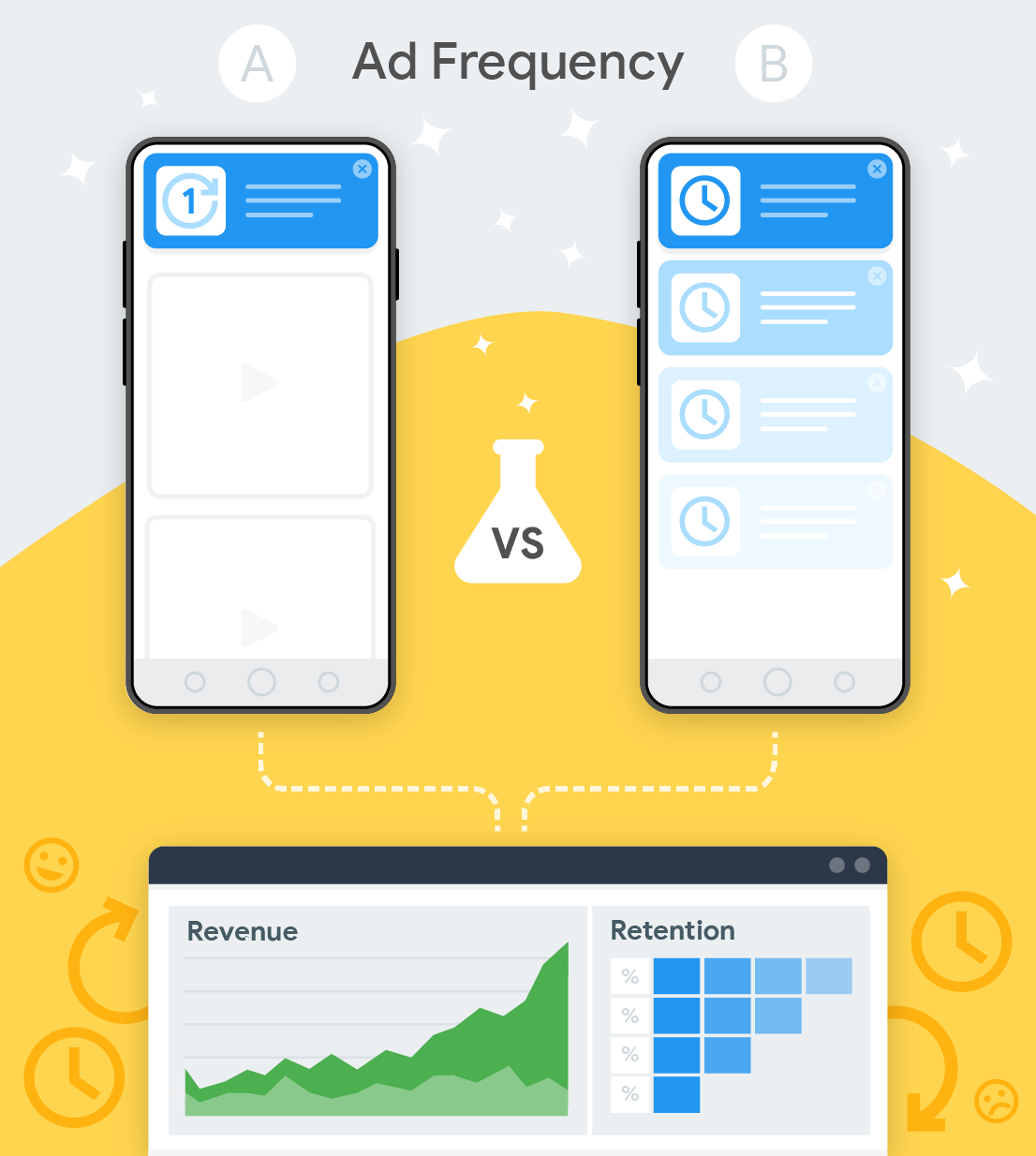
解决方案教程
在保持高质量用户体验的同时优化广告频率可能是一件棘手的事,但 Firebase 提供了一些工具,用于帮助您进行测试,然后根据数据作出有关适宜广告频率的决策。
使用 Firebase,您可以面向一小部分用户对各种广告频率的效果执行 A/B 测试。
您可以观察测试结果,并查看 Firebase 关于哪种广告频率效果较好且对留存率的影响最小的建议。
确信更改可能会产生积极影响后,您只需点击一下按钮,即可向更多用户发布更改。
学习内容
在本教程中,您将学习如何使用 Firebase 针对您应用中的 Google AdMob 广告测试各种频次上限。本教程使用插页式广告作为示例测试用例,但您可以推广并使用这些步骤来测试其他广告格式的频次上限。
本教程假定您已在应用中使用 AdMob,并且想要测试更改插页式广告单元的频率是否会影响应用的收入或其他指标。不过,如果您尚未在应用中使用 AdMob,也没有关系!本教程中的步骤还有助于您了解应该在应用中使用哪种广告频率。
如需详细了解此解决方案的业务案例和价值,请参阅我们的“优化 AdMob 广告频次”解决方案概览。
本教程中使用的产品和功能
|
Google AdMob 借助 Google AdMob,您可以创建具有不同广告展示频次或刷新率的广告单元,这些广告单元将在您的应用内投放。将 AdMob 与 Firebase 相关联后,AdMob 会向 Firebase 发送广告收入信息,以改善广告策略优化。 Google Analytics Google Analytics 可让您深入了解用户互动度、留存率和创收指标,例如总收入、AdMob 收入、购买收入等等。它还允许您创建用户受众群体和细分用户群。 |
Firebase Remote Config Firebase Remote Config 可让您为所需的细分用户群动态更改和自定义应用的行为和外观,且不需要发布应用的新版本。在本教程中,您将使用 Remote Config 参数来控制向用户显示哪个广告单元。 Firebase A/B Testing Firebase A/B Testing 提供了用于在应用中运行产品和营销实验的界面和基础架构。它负责向用户分发实验变体,然后根据您选择的关键指标(例如收入或用户留存率)执行统计分析,以确定实验变体的效果是否优于对照组。 |

教程概览
-
在 AdMob 中创建两个新的插页式广告单元。
将每个广告单元的频次上限设置为您要测试的“每位用户展示次数”值。
在应用代码中实现广告单元展示位置。
-
定义测试基本信息、定位以及运行测试的目标。
定义测试变体并设置 Remote Config 参数,用于控制在测试中向用户显示哪个广告单元。
-
在应用中使用 Remote Config 参数。
实现根据参数值显示广告单元的逻辑。
在 Firebase 控制台中启动 A/B 测试并查看测试结果
在启动测试并让测试运行几天或几周后,查看 Firebase 控制台,根据 A/B 测试的主要目标来确定 A/B 测试是否有胜出的变体。
查看每个变体对次要指标的影响,以确保变体不会对这些指标产生意外的负面影响。
-
如果 A/B Testing 确定胜出者是显示新广告格式的变体,则您可以开始向实验所定位的所有用户、您应用的所有用户或您的部分用户显示该广告格式。
如果尚未确定明确的胜出者,则您可以继续运行实验以收集更多数据,或者如果实验已经运行了很长一段时间,仍不确定结果,则可以结束实验。
您需要满足的条件
您自己的应用(iOS、Android 或 Unity 项目)
您的应用已注册为与 AdMob 应用相关联的 Firebase 应用(了解详情)
您有权访问您应用的关联 AdMob 账号,并且有权创建新的广告单元
有权访问您应用的关联 Firebase 项目,并且有权创建和管理 Remote Config 和 A/B Testing 以及查看 Google Analytics
您首选的 IDE

